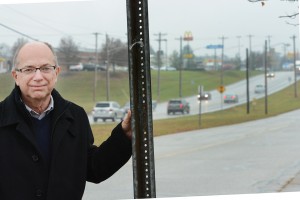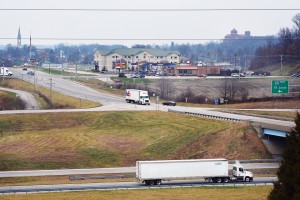 Dubois Rural Electric Cooperative General Manager Don Book need drive only minutes in any direction from his office to see what he calls the “could’ve beens” and “should’ve beens” for the 11,000-member co-op.
Dubois Rural Electric Cooperative General Manager Don Book need drive only minutes in any direction from his office to see what he calls the “could’ve beens” and “should’ve beens” for the 11,000-member co-op.
A Walmart, a Home Depot, fast-food franchises, retail centers and condominiums line U.S. 231 to the north of Jasper; Jasper High School, upscale homes, more businesses are to the west; to the south and east, along the fringes of Jasper, Huntingburg and Ferdinand, industry, more retail and housing divisions flourish.
All are on territory once served electrically by the REC, back when the land was mostly cornfields. But as the three communities grew, they annexed the land. And, taking advantage of a provision in state law, their municipal electric utilities grabbed the service territory away from the consumer-owned co-op.
“We would look a lot different,” Book said of the REC, “if we could have kept it all. We’d have density that we don’t have now. We’d have revenues we can only imagine. We’d be one of the bigger co-ops in Indiana. That’s the part that is kind of depressing …,” he lamented, “the members they’ve taken. Some of our best loads are gone.”
Gone, but not forgotten
It’s a familiar tale told around Indiana wherever a city or town owns and operates its own electric utility — and is predatory about territory.
From the city of Jasper in the south to Jasper County in the north; from Hancock County east of Indianapolis and back south to Perry County on the banks of the Ohio River — municipal electric utilities (munis) can and do seize desirable new territory and customers from the incumbent utility, either a consumer-owned co-op or an investor-owned utility (IOU).
Only munis are allowed to take territory from another utility without a mutual agreement. While munis are required to compensate co-ops and IOUs for the lost territory, co-ops say they are receiving far less than fair market value and any compensation goes away after five years.
Book estimates his co-op loses $11 million a year in electricity sales from the territories the co-op has lost to the three neighborhood munis. At NineStar Connect, the Greenfield-based electric co-op serving almost 13,000 consumers in Hancock and three other counties directly east of Indianapolis, lost gross revenue is approaching $17 million annually.
This month, Indiana’s electric cooperatives, working with the five large investor-owned utilities serving Hoosiers, are asking the General Assembly to strike the provision in the territory law that gives munis this advantage. State Sen. Michael Crider of Greenfield, a NineStar Connect member, has agreed to take up the red pen as author of the bill that deletes the unfair provision and would allow the incumbent utility to keep its service territory whole.

Dubois REC General Manager Don Book stands along U.S. 231 on the north side of Jasper. The high-density area, home to a Home Depot, Walmart, multiple fast-food franchises, retail centers, homes, condominiums and more was once served by the REC. It’s the kind of electric load density that would benefit all the co-op’s 11,000-some consumers. But when Jasper annexed the area a few decades ago, as the city expanded north, its municipal electric utility snatched the area away, thanks to a provision in Indiana state law governing electric utility territory. City-owned electric utilities are the only ones allowed to cherry pick whatever areas they want (or leave undesirable areas to the incumbent utility) after an annexation. Indiana’s electric cooperatives and the investor-owned utilities are attempting to have the unfair provision struck in this session of the General Assembly.
While municipal electric companies have argued such legislation would place severe restrictions on their growth and on serving customers in annexed areas, electric co-ops say preserving established territories and creating fairness for all utilities better serves all of Indiana’s electric consumers.
“It is our contention that affordability is better achieved by honoring utility boundaries and preserving the right of the incumbent provider,” said Brian Christenberry, state government relations manager with Indiana Electric Cooperatives. “Preserving service boundaries allows and encourages local units of government, IOUs and cooperatives to work together to achieve the best results for communities across Indiana.”
Electric cooperatives emphatically note they are not opposed to annexation and growth of cities and towns. “Our issue is with the current territory law, which negatively impacts our members,” Book said.
When a municipality takes a large industrial user from a co-op after an annexation, it not only is a loss in revenue, but it leaves pockets of stranded members who still must be served by the co-op. In those cases, the co-op must still maintain its power lines and rights-of-way running through the taken territory. On the fringes of Jasper and Huntingburg, for example, Dubois REC power lines that have stood for decades now go untapped for long stretches. On the other side of the road stand newer muni poles and lines which sometimes have to cross under the co-op’s lines to serve their new customers.
And, a loss for one cooperative is a loss for all cooperatives and all consumers because their power generation is jointly owned by member cooperatives, and, by extension, the members of the distribution co-ops. Co-op power suppliers work on forecasts, sometimes 30 to 40 years ahead, and make capital investments, such as power plants, transmission lines, and substations, based on who they serve now and project to serve into the future. When load is lost or assumed growth does not occur, these fixed costs must be recovered from a smaller base.
In effect, the 7 percent of Hoosiers who receive electricity from a muni are getting a state-sanctioned break in their electric rates to the detriment of the 93 percent of Hoosiers who receive electricity from co-ops and IOUs.
“We would look a lot different if we could have kept it all. We’d have density that we don’t have now. We’d have revenues we can only imagine… That’s the part that is kind of depressing… the members they’ve taken. Some of our best loads are gone.”
— Don Book, Dubois REC general manager
Co-ops, which serve some of the most economically depressed and geographically challenging areas of the state, are also at the added disadvantage of serving only an average of eight consumers per mile of line. Contrast this to the 48 consumers per mile the munis serve. It’s easy to see why munis, on a national average, generate $113,000 of revenue per mile of line to the co-ops’ $15,000.
The density dilemma
Co-ops are asking consumers to let their state legislators know this issue affects all of Indiana’s cooperatives. And it isn’t just about fairness. Because co-ops are not-for-profit and are owned and controlled by their consumers, it’s a pocket-book issue that affects the bottom line of co-op consumers statewide.
It’s all about density — how many consumers a utility serves per mile of line — said Bryan Washburn, CEO at Jasper County REMC which has had existing consumers and promising territory plundered by Rensselaer’s electric utility.
“Density has a direct impact to rates. The more consumers we lose, the more it hurts us,” Washburn said. “Every time a big business comes along that is directly adjacent to them, they annex the land.”
Farmers and rural residents formed electric co-ops in the 1930s and ’40s to bring electricity out beyond the edges of towns because the existing utilities deemed such low-density areas too expensive to serve. Co-ops have worked hard ever since to bring in loads and spread costs to benefit all their consumers — which also benefit the entire area with jobs and tax dollars.
“Co-ops don’t have the luxury of looking outside their territory for growth and economic development,” noted Christenberry. “The fact we are growing at such a rate is a testament to the development professionals within our cooperatives that attract business and industry as well as invest in current customers. Unfortunately, this type of desired growth is exactly what makes us attractive to municipal electricity providers.”
Washburn said the loss of territory from a 2012 annexation took almost 1.5 percent of the REMC’s total annual revenue away. That territory grab took a corridor along Indiana 114 — from Rensselaer’s west side out to an interchange with Interstate 65. Lost to the REMC were 65 different accounts — 46 homes, 19 businesses, restaurants and a hotel. For a typical co-op like Jasper County REMC, with only 7,500 consumers and a density of less than seven consumers per mile of line, that’s a loss that stings and takes years to recover.
Since 1983, NineStar has lost over 5,800 acres of service territory to Greenfield Power & Light, notes Michael Burrow, NineStar’s president and CEO. Those takeovers have denied the co-op growth of over 4,200 meters. “We would be over 30 percent larger than we are today,” he said.
Instead of taking already robust areas that require larger reparations to the incumbent utility, Greenfield, literally, has been annexing green fields. Then, the city’s electric utility comes right in behind to take over the electric service.
“For a long time, Greenfield has been ground-zero for very aggressive annexation,” Burrow said. “Greenfield goes after largely undeveloped property — property that might have a farmhouse or two that we’ve served since the 1930s. They’ll go after that 80 acres because they know a development is coming: a big factory or a big housing project.”
When there’s no development on a piece of annexed land, the city can avoid paying even small damages to NineStar. “This arguably is NineStar’s biggest issue,” Burrow noted.
Burrow said the rationale municipalities and their statewide power agency offer for the takeovers — saying they want all city residents to have city services — is disingenuous at best. “Why didn’t they annex the land 40-60 years ago? Because they didn’t want it when the electric load density was low, and the cost to serve it was high. They wait until they know the load density will soon be high, and the cost to serve is low.”
He said the municipals are strictly making pragmatic business decisions based on cost over which piece of land to annex, and which piece of land to serve or not serve even within an annexed area. “It’s tantamount to cherry picking,” Burrow said. “The state statute, as it is, gives them a competitive advantage over co-ops and IOUs. The state government is picking winners and losers. We need a level playing field.”

Traffic streams along the bustling Interstate 64/Indiana 162 interchange on the southern fringe of Ferdinand. Southern Indiana Power, an electric cooperative, once served the area surrounding the interchange until the town annexed the corridor to the interstate before it developed. Ferdinand’s municipal electric utility took over service. The town left a farmhouse, just to the west, out of the annexation which the co-op still serves.
At Dubois REC, Book says the “hole” in the territory law is leaving holes: in the co-op’s service area and its books. The revenues lost to the three neighborhood munis means the remaining co-op consumers must pay for the fixed costs of operating the co-op — the poles, transformers, wire, line crews and equipment.
“We’re primarily residential,” Book said. “Residential loads will peak late in the evening when everybody gets home from work. Commercial accounts don’t follow that same pattern. So, they help fill in the valleys and help us be more efficient.”
A cooperative runs more efficiently if it can use a steady stream of electricity throughout the day to help soften the peaks. Commercial and industrial consumers help do this. That’s why municipal electrics cross the line — gerrymandering territory to best suit their bottom line.
The municipal electrics defend the state statute by pointing out the rapid growth of electric cooperatives in comparison to the munis statewide. But not every cooperative is seeing expansive growth. Dubois is one of those. Most of its growth is from camp areas around Patoka Lake on its east side and out in the rolling rural countryside where poultry farms help maintain a stable load. “We’re fortunate the turkey and chicken houses are doing well,” Book added. “The reason I guess the cities haven’t taken them is they don’t want a turkey or a chicken house inside city limits.”
“It’s tantamount to cherry picking. The state statute, as it is, gives [municipal electric utilities] a competitive advantage over co-ops and IOUs. The state government is picking winners and losers. We need a level playing field.”
— Michael Burrow, NineStar Connect President and CEO
Book noted that co-ops like Dubois REC, which extends east into the hills of Crawford County, cover some of the hardest-to-serve areas of Indiana. “We have electric lines extending into the Hoosier National Forest, where right-of-way maintenance is expensive and outage restoration can be slowed by the terrain. On the other hand, the easiest areas to serve are the urban areas in or near the towns and cities. To lose these best loads to the munis only increases the cost to our members,” Book said. “It’s starting to add up after they do it year after year after year,” he said.
Mounting losses
Since 2002, munis have filed over 80 petitions to change service territory resulting in loss of territory to co-ops and the state’s IOUs. Indiana’s electric cooperatives figure this adds up to some $44.2 million in lost annual revenues just for the four most affected co-ops — Dubois, Jasper, NineStar and Boone REMC.
The Indiana Municipal Power Agency, a wholesale power provider to the state’s municipal electrics, likes to note that only 28 of the state’s 72 municipal electric communities have taken advantage of the law in the past 25 years.
And true, only a handful of Indiana’s 38 electric co-ops have had territory taken by munis since a hard-fought 1980 territory protection law was passed. That’s when the Indiana General Assembly set utility territories to avoid duplication of services and maintain affordability for all of Indiana’s electric consumers. But munis were allowed to be exempt from these rules.
In 2002, an attempt to adjust the 1980 law came to a compromise that gave co-ops and IOUs some compensation for the loss of territory. Co-ops insist the reparations are far from fair market value. What’s more: the rate of takeovers actually has only accelerated since then.
For developed territory it takes, a muni must pay a co-op or IOU two and a half times the annual gross revenue from the area. It also must pay the incumbent utility for all the poles, line, transformers, etc., it takes in the area, less depreciation. Book noted that cost is enough to prevent some munis from taking over annexed areas — unless the area is still ripe for heavier development.
For cornfields and bare land that later develop, the muni has to pay the losing utility only a dollar per megawatt-hour the new consumers buy from the muni each month, capped at $170 per month, for the first five years after annexation. Book notes that last year, Dubois received a payment of just $228.97 from the city of Jasper for 31 new accounts in an area the city took away from the co-op in 2007. That’s hardly the monthly bill for a single residential consumer.
Total payments the REC received for the loss of Home Depot was a little less than $7,300. “Although better than nothing,” Book said, “it isn’t a lot of money when you consider this account could have reasonably brought in $4.5 million in revenue to the co-op over its life, revenue that is now going to the city of Jasper.”
For the five co-ops most affected — Boone REMC, Dubois REC, Jasper County REMC, NineStar Connect and Southern Indiana Power — the losses do count. But 33 of the state’s 38 co-ops have municipals operating beside them. While many co-ops enjoy good working relations with munis in their area, the state statute keeps the specter of territory takeover like the proverbial “sword of Damocles” hanging by a slender thread over the heads of all co-ops. And the loss for one co-op ripples out to all.
Predatory annexation
Washburn may not agree with, but said he can understand, Rensselaer’s electric utility taking the land on U.S. 231 north of town years ago when the new county jail was going to be built. Same with the taking of land on the eastern edge of town when plans for the new high school were announced. But the 2012 taking of the corridor out to I-65? … He’s still shaking his head incredulously.
“This up here made no economic sense to me whatsoever,” he said.
With the severance formula required by state law, the muni paid the REMC almost $850,000 for that stretch. Washburn said when you figure in the return, Rensselaer won’t see a payback on that takeover for 50 years. What’s more, those businesses in the annexed area are still waiting for the promised city water lines.
“The people out there had a real need for sewer,” Washburn said. He met with city officials with a plan he thought was a win-win-win for all involved: the consumers there would get city water and sewer, Rensselaer would have a new customer base for those services, and the REMC would get to keep its consumers.
Washburn said as part of his solution, the REMC would seek a $740,000 Rural Economic Development Loan and Grant (REDLG) the U.S. Department of Agriculture makes available through rural utilities. The REMC, which would have to repay the loan to the USDA, was going to offer Rensselaer the money on a 10-year loan at no interest to extend the city water lines. Washburn said the city rejected the plan. It wanted all the services. “Today, they’ve got the sewer, but we’re three years past, and they still don’t have water out there because the city can’t afford it,” he said.
“By working together, we could’ve solved those problems out there. But this predatory annexation, and ‘we want the whole thing’ … it’s just the wrong way to work. As a cooperative, I thought we were better off to work in concert with them for the betterment of the community. But they thumbed their nose at us.”
A level playing field
On the other end of the state, relations between Southern Indiana Power (SIP) and Tell City’s electric utility is less testy perhaps than Jasper County REMC and Rensselaer’s, but that doesn’t mean SIP should assume cooperation since the city electric utility always holds the upper hand.
Tell City is attempting an annexation to its north and east of some 1,700 acres. It has met opposition from many of those living in the proposed area. A court will decide the proposal this spring. The city’s original annexation plan had the city electric utility taking 200 of the co-op’s members and the land where a new hospital for Perry County is being constructed.
The co-op was able to negotiate the loss of consumers down to just 36, but that includes the new hospital which is expected to open later this year. Part of the deal SIP used to keep most of its consumers within the annexation was an offer to tap REDLG funds to help build a new water tower for the city to develop the annexed area.
“The Tell City electric department’s focus was the new hospital,” said Steve Seibert, president and CEO of SIP which is based in Tell City. “In our negotiations, their argument for serving the new hospital was that they serve the present one now, and they’d lose load and revenue.”
Seibert noted that’s when a red flag went up in his mind. “So, I told them: ‘I want you to stop for just a minute and understand what you just said. Because when you’re potentially losing something, then you can relate to what the gentleman on the other side of the table — which is me — is feeling during this process.”
Seibert said, “I could see our agreement with the city of Tell City being an example of how a municipal and a co-op could work together vs. working against each other.”
Even with an agreement now, things could change if the annexation plan is defeated and another annexation is attempted, or if and when a new administration takes office. “There’s never any certainty with the way the current territory law is written,” Seibert said.
“For service territory to change,” Seibert said, echoing the sentiment of electric cooperatives around the state, “there should be a two-party agreement that benefits both sides. The basis of our proposed legislation is just to create fairness in the process. It’s a fairness issue.”



